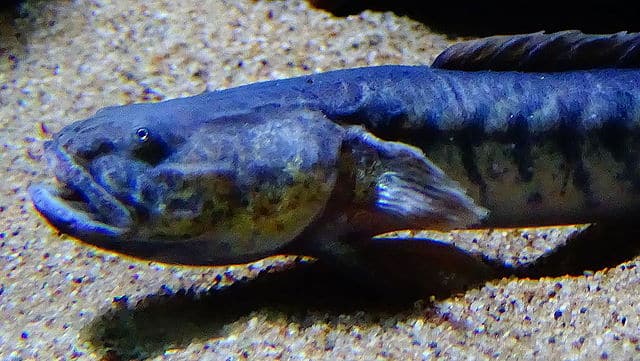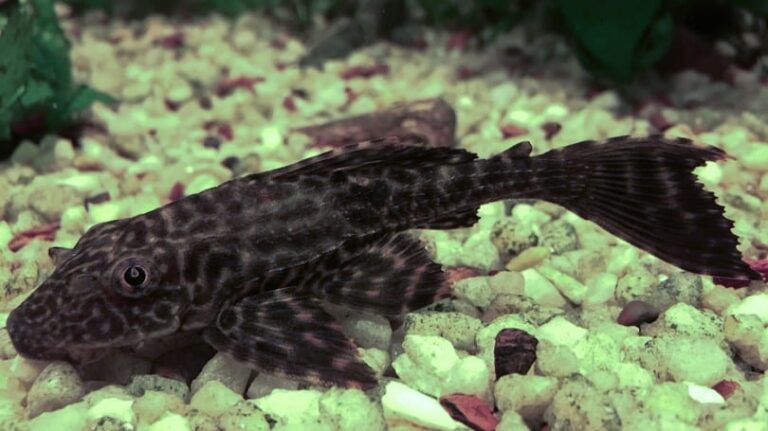Dragon Goby: The Ultimate Guide
If you have ever considered keeping an aquarium fish that looks like it’s from the age of dinosaurs, then it is time to introduce you to the Dragon Goby, a creature with a prehistoric appearance that brings a unique charm to your underwater world.
The name Dragon Goby comes from its metallic look, which is comparable to dragon scales. But hold on, while excitement overwhelms you and drives you to make impulsive decisions, It’s essential to ensure that you are armed with the relevant knowledge needed for your Dragon Goby’s comfort and welfare.
So, what is required to create a habitat that will ideally maintain these unique fish? Let’s find out thorough information for successfully keeping dragon goby!

Dragon Goby Origin & Appearance
One of the most widely available species in the fish-keeping industry, the dragon goby is a member of the Gobiidae family and has a native range extending from South Carolina to the Gulf of Mexico and Brazil. Due to their round heads, long, thin bodies, and black coloring, dragon gobies are frequently mistaken for eels.
These fish may have fearsome-looking teeth, but in the wild, they are solely employed to scrape algae off rocks. On the side of their heads, dragon gobies have tiny eyes. Their vision is so bad that they are virtually completely blind. To navigate the tank, they use their jaws and fins.
Occasionally brown or gray, dragon gobies can turn silvery blue in the appropriate water, earning them the nickname “violet goby.” This blue color is speckled with yellow areas; the fish are healthier and happier when their coloring is more bright.
Compared to the majority of other goby species, the dragon goby frequently grows larger in the wild. In a home aquarium, they rarely exceed 15 inches in length, with a maximum length of 24 inches.

Behaviour & Temperament of Dragon Goby
These shy dwellers will frequently be found at the bottom of the aquarium. If dragon gobies don’t have enough room in the tank, they can be territorial, which could result in aggressive behavior. Because they are nocturnal, dragon gobies spend the majority of the day hiding out before becoming more active at night.
Despite having sharp teeth, they rarely bite fish that aren’t irritating them. Despite their teeth, they rarely fight fish that aren’t irritating them. They only show symptoms of hostility when breeding or when they have an area they want to defend.
When kept in captivity, the dragon goby has been seen to live up to 10 to 12 years. Additionally, it has been observed that these fish can live for more than a decade, although it is extremely unlikely that this will ever happen.

How to Take Care of Dragon Goby? 3 Main Considerations
1. Water Parameters
For the health and welfare of your dragon goby, it’s essential to maintain adequate water conditions. The ideal water temperature should be maintained between 75 and 80 degrees Fahrenheit. Maintain a pH of 7.0 to 8.5. Although dragon gobies can endure a wide pH range, it’s important to maintain stability to prevent stress.
Ensure that the water hardness is between 10 and 20 dH. Dragon gobies thrive in this somewhat hard to very hard water environment. Keep close track of the amounts of ammonia, nitrite, and nitrate. Nitrate levels should be kept at 20 ppm, while ammonia and nitrite concentrations should always be below zero ppm.
To preserve the quality of the water, perform routine water changes. Depending on the bioload and tank size, replace 20 to 30 percent of the water in your aquarium every 2 weeks. Use a reliable test kit to keep track of the water’s parameters. Regular testing will enable you to address any problems as soon as they arise and prevent any potential health risks for your dragon goby.
To get rid of dangerous elements and guarantee the water is secure for your fish, always use a water conditioner. Keep an eye on the stability of the tank. Maintaining consistency is essential since any sudden shifts in water parameters could cause stress and health problems in your dragon goby.
2. Tank Arrangement
Choosing a dark substrate, like black sand, can help you achieve your goal of simulating a swampy environment similar to the estuaries of their natural home. Gravel wouldn’t be a safe substrate choice for a dragon goby because it would sift through the sand with its mouth to find food.
As a way to enrich the tank and keep the water’s hardness and alkalinity stable, several aquarists suggested combining aragonite crystals with black sand. Because of the dark sand, the crystals can’t reflect light and harm the fish’s eyesight.
3. Decoration
Because dragon gobies are a timid kind of fish, the aquarium needs to have lots of places for them to hide. You may employ anything that provides shelter as a decoration, including plants, rocks, and caverns. When nestling into their safe spot, dragon goby may nick themselves on sharp rocks, so choose rocks that aren’t too pointy.
Anubias, hairgrass, and java fern are just a few examples of the many plants that are beneficial to fish and will keep them happy. The plants should ideally be secured below the substrate level since dragon goby are renowned for burrowing and disrupting the sand when in search of food. Since these fish are nocturnal and spend the majority of the day hiding, mild lighting is all that is required to maintain their happiness.
How to Feed Dragon Goby
Due to their omnivorous nature, dragon gobies need to eat a variety of different things. The best way to guarantee they get the nourishment they need for good health is to give them a range of food sources. As the main component of their food, provide high-quality algae wafers or sinking pellets. The vital vitamins, minerals, and nutrients in these items are specially designed to feed your fish.
In addition to feedings, include live or frozen items. Excellent options include bloodworms, brine shrimp, and tubifex worms since they add to the variety of protein sources available and promote foraging in the wild.
Don’t forget to periodically include fresh vegetables. Blanched vegetables, like spinach, lettuce, and zucchini, may be a fantastic source of vitamins and fiber. Feed your dragon goby once or twice a day, giving them no more food than they can finish in 3 to 5 minutes.
Keep an eye on your dragon goby’s eating patterns and modify feeding as necessary. Be aware that shifts in feeding habits or appetite could indicate stress or a health issue. To prevent leftover food and waste from polluting the water, keep the tank clean. The general health and well-being of your Dragon Goby depend on regular tank maintenance.
Choosing Tank Mates for Dragon Goby
Maintaining a peaceful environment for your dragon goby requires choosing compatible tank mates. To keep your dragon goby from becoming stressed, choose companion fish with comparable water needs and personalities. The best tank mates for fish are peaceful, non-aggressive creatures. Dragon gobies can coexist peacefully with species like Platies, Swordtails, Mollies, Angelfish, and smaller Gouramis.
Keep your dragon goby separate from fish that are violent or territorial, like Oscars and tiger barbs. These species could harass or harm the goby, stressing it out and possibly resulting in health problems. To reduce competition for space and resources, bottom-dwelling species that inhabit a similar environment should also be avoided.
Dragon Gobies can live peacefully among invertebrates like Cherry and Bamboo shrimps, Nerite snails, and Mystery snails. By eating algae and leftover food, these animals can even contribute to keeping the aquarium clean.
Introduce new tank mates gradually and keep a close eye on interactions. With this strategy, both your dragon goby and its tank mates can become used to their new company. To accommodate all of its occupants, make sure your aquarium has lots of hiding places, swimming areas, and resources. A calm habitat for all of your fish can be created with careful design and consideration.
Common Health Concerns
Dragon gobies are susceptible to illnesses that afflict a wide range of fish species kept in home aquariums. But still, the majority of this species’ health problems are brought on by a bad diet, stress, or unsuitable water conditions.
If you observe white patches on the fish’s skin, you should know that they are caused by the common parasite Ich. A white rim around the fin is also a sign of a bacterial illness. Fin rot and columnar, sometimes called cottonmouth, often result in skin sores and gill degradation. If you notice any of these signs, keep in mind that veterinarians recommend animal antibiotics as the best method to treat common health concerns in dragon gobies.
Conclusion
After learning the fundamentals of caring for a dragon goby, you are now prepared to establish a healthy environment for your new aquatic companion. This aquatic critter will undoubtedly become a household favorite due to its charming behavior and capacity to adapt to various aquarium settings. So, we wish you success in raising Dragon Goby!

Nato is a content writer and researcher with a background in psychology who’s eager to explore the wonders of nature. As a travel enthusiast and animal lover, she hopes to inspire others to discover and cherish the beauty and importance of the natural world.







